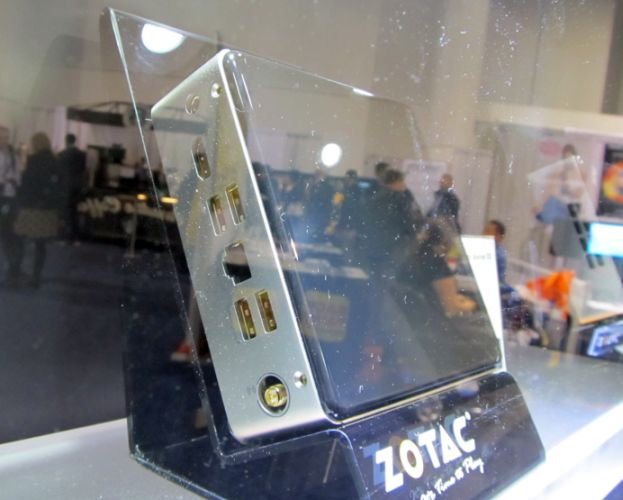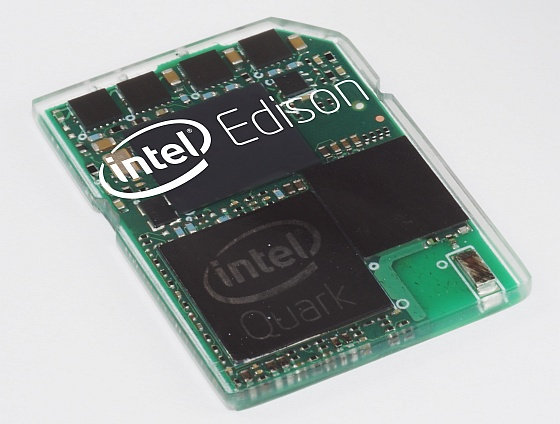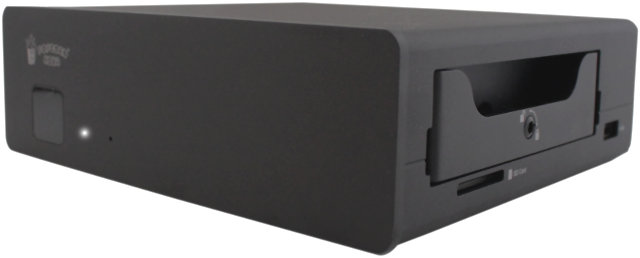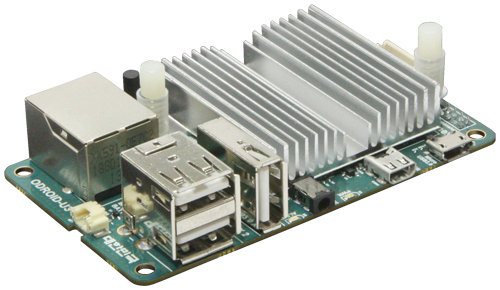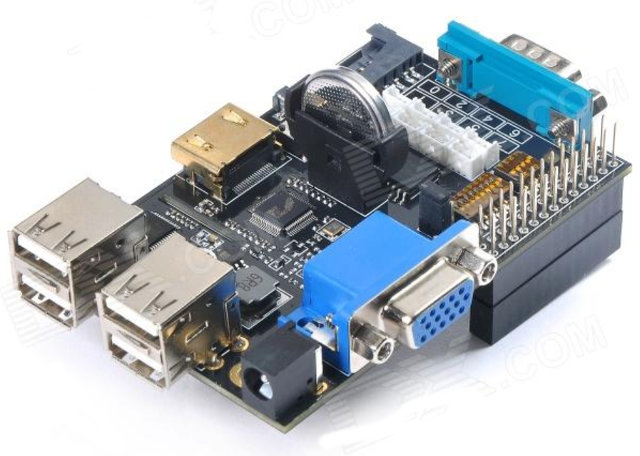ZOTAC, a company known to provide small x86 Linux PCs, is currently showcasing an ARM based version at CES 2014, part of their ZBOX nano series, running either Ubuntu 12.04 or Android 4.2 on a Freescale i.MX 6Quad processor. ZOTAC ZBox nano “ARM” specifications: SoC – Freescale i.MX 6Q quad core Cortex A9 @ 1 Ghz with Vivante GC2000 GPU System Memory – 1GB DDR3 Storage – 8GB eMMC flash, SATA 3Gb/s interface with 2.5″ HDD support, and SD card slot (SD/SDHC/MMC) Video Output – HDMI 1.4 USB – 4x USB 2.0 host port Connectivity – GbE Ethernet, and Wi-Fi 802.11 b/g/n via mini PCIe module. The computer currently runs Android 4.0.4 and Ubuntu 12.04 LTS, but Android 4.0.4 will be upgraded to Android 4.2. ZBOX nano “ARM” mini PC will be available in Q2 2014 for a price between $100 and $150. Via Liliputing Jean-Luc Aufranc (CNXSoft)Jean-Luc started CNX […]
Intel Unveils Edison Board for Wearables at CES 2014 Keynote
After an earlier Intel presentation about Intel RealSense Technology by Mooly Eden, Intel Senior Vice President and General Manager, the newly appointed Intel CEO, Brian Krzanich, officially opened CES 2014 with the pre-show keynote. This time there was nothing about processors for PCs, and the announcement the most interesting and relevant to this blog was Intel Edison, a tiny SD-card sized board powered by a dual core Quark SoC. Specifications: SoC – Unnamed and new dual core Intel Quark SoC @ 400MHz manufactured with 22nm process technology. MCU – Unnamed Intel MCU (MCS 51??) to manage I/Os and other baseline functions. System Memory – LPDDR2 Storage – NAND Flash Connectivity – Wi-Fi and Blutooth 4.0 LE Dimensions – Just like an SD card The board will support Linux, and common open source tools used by the marker community. It will also support Wolfgram language and Mathematica. There will also be […]
Popcorn Hour A-410 Linux Based Networked Media Jukebox is Now Available for Pre-order for $259
CloudMedia, previously known a Syabas, has announced the available of Popcorn Hour A410, a networked media jukebox (NMJ) powered by Sigma Designs SMP8911 dual core processor with 1GB RAM, Gigabit Ethernet, support for 2.5″ and 3.5″ SATA drives, USB 3.0, and numerous audio / video ports. It can be used as a media player, as well as a NAS (Networked Access Storage). Popcorn Hour A410 specifications: SoC – Sigma Designs SMP8911 Dual-Core 800Mhz processor (MIPS) with 512KB L2 Cache and VXP Video Processor System Memory – 1024MB DDR2 Storage – 256MB SLC NAND Flash, SD Card reader, 2.5″ and 3.5″ SATA HDD bay, and eSATA connector. Audio/Video I/Os – HDMI, Component, CVBS, Stereo Audio, optical and coaxial S/PDIF. Audio DAC – ESS Sabre Audiophile class DAC (24-bit, 192 Khz sampling rate) Video containers – MPEG1/2/4 Elementary (M1V, M2V, M4V),MPEG1/2 PS (M2P, MPG, DAT, VOB),MPEG2 Transport Stream (TS, TP, TRP, M2T, […]
Top 10 Posts of 2013 and Stats on CNXSoft Blog
This is the last day of the year, and just like in 2012, I’ll look back on the main trends of this year, post a list of the top 10 posts of 2013 on cnx-software.com, and add some fun stats about the site and my visitors. 2013 has been the year of quad core media players and mini PCs, especially those based on Rockchip RK3188, XBMC is now featured in many Android STBs, “big.LITTLE” and “Octa-core” have been the buzz words on the application processor front, Google has entered the HDMI TV sticks market with the ChromeCast, and is competing with Miracast / DLNA TV dongles, we’ve gotten more and more low cost Linux development boards, crowdfunding has almost gone mainstream, and the Internet of things has started to take off thanks to new technologies such as Bluetooth Low Energy. I’ve compiled the list using data from Google Analytics, filtered […]
Bodhi Linux Distribution Has Dropped Official ARM Support (For a While)
Linux is omnipresent in your life via gadget running Android, but in the desktop world, as many of you already know, it’s not straightforward to get a Linux distribution fully work on ARM platform, because each ARM SoC or board is different, and above all binary blobs used for GPUs, VPUs, Wi-Fi and Bluetooth chips can make it extremely complex, even impossible, to have a fully working ARM Linux distribution for a given hardware. After considering that ARM Linux required too much effort, and was not used by many people, Bodhi Linux developers decided to call it a day in October this year, and dropped official support for ARM hard-float images: Effective immediately Bodhi is dropping official support for ARM devices. What does this mean? We will no longer be advertising an ARMHF download link on our front page Updates to ARM images will be infrequent/not at all. The ARM […]
Hardkernel Unveils $59 ODROID-U3 Board Powered by Exynos 4412 Prime Quad Core SoC
Hardkernel ODROID board family already features of the most cost effective development / hobbyist boards in the market. But the company has done it again, with ODROID-U3 a quad core board, software compatible with ODROID-U2, that sells for just $59 + shipping. ODROID-U3 specifications: SoC – Samsung Exynos 4412 Prime @ 1.7 Ghz with ARM Mali-400MP4 GPU @ 440MHz System Memory – 2GB @ 880MHz Storage – microSD slot, eMMC module socket USB – 3x USB 2.0 Host ports, 1x USB 2.0 device for ADB/mass storage Ethernet – 10/100Mbps (LAN9730) Video Output – micro HDMI Audio Output – 3.5mm Jack, micro HDMI System Console – UART (1.8Volt) DC Power – 5V/2A PCB Dimension – 83 x 48mm Weight – 48g with heatsink The company provides images and source code for Xubuntu 13.10, Android 4.x with u-boot 2010.12 and kernel 3.8, as well as the schematics (PDF). Support is available on […]
X100 Raspberry Pi Expansion Board Adds VGA Output, RTC and More
Suptronics X100 is an expansion board that connects on top of the Raspberry Pi in order to add VGA output, RTC, four USB ports, a micro SD card slot, an RS232 DB9 connector, and an 8-channel servo port. Key features of X100 expansion board: Input Voltage – 6V to 23V converted to 5V, 3A via step-down DC/DC converter to power the Raspberry Pi. VGA – HDMI to VGA converter supporting up to UXGA (1600×1200) and 1080p with 10-bit DAC USB – self-powered USB hub with 4 ports Storage – micro SD card reader RTC – NXP PCF2127AT / PCF2129AT with included CR2032 battery Debugging – RS232 DB9 connector (via MAX3232) to be used with a null-modem cable. I/Os – Reset switch for RPi reset, headers to access S1 & S5 on top of the Raspberry Pi Servo support – 8-channel Darlington driver chip (ULN2803) allowing to control electronic circuits […]
Linaro 13.12 Release with Linux Kernel 3.13, Android 4.4, and Ubuntu Saucy Salamander
Due to the end of year celebration, Linaro release is a little earlier at this time, and Linaro 13.12 has already been released with Linux Kernel 3.13-rc3 (baseline), Linux Kernel 3.10.24 (LSK), Android 4.4, and Ubuntu Linaro 13.12, which for the first time is based on Ubuntu 13.10 Saucy Salamander. Other interesting development include an initial arm64 Ubuntu saucy rootfs (that one?), work to support octa-core 4x Cortex A53, 4x Cortex A57 SoCs, an Android 4.4 KitKat LEB for the Galaxy Nexus, and ARMv8 LSK and Nexus7_2013-AOSP builds have been setup and Android can be now built using llvm-clang toolchain with the related patches submitted to upstream. On a related note, there are also some Midway and Highbank engineering build images for Calxeda server processors, which may not be that useful going forward, as unfortunately the company has just closed door after running out of cash. Here are the highlights of this […]


